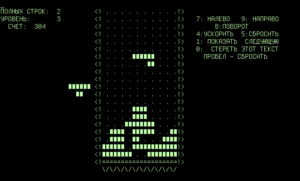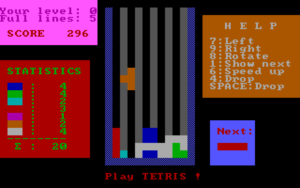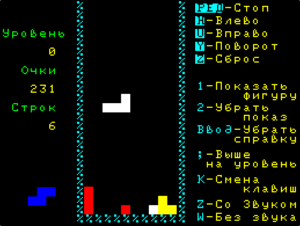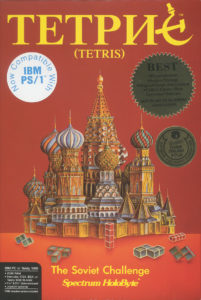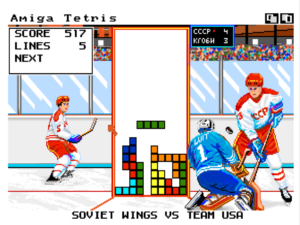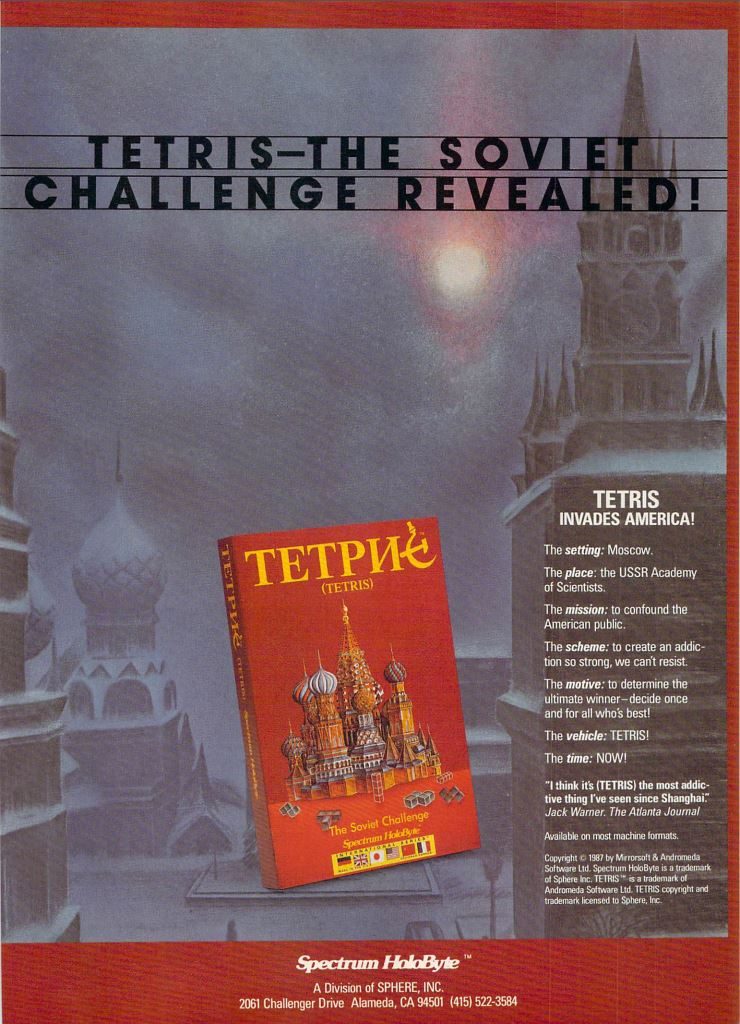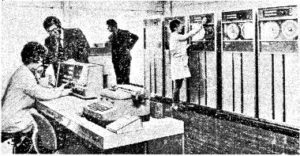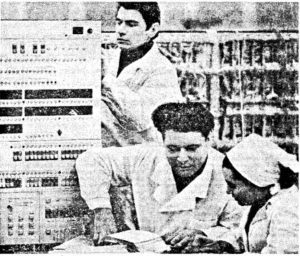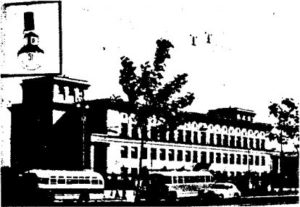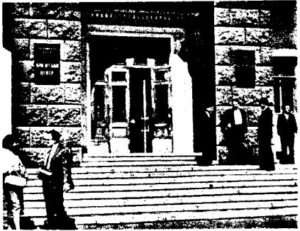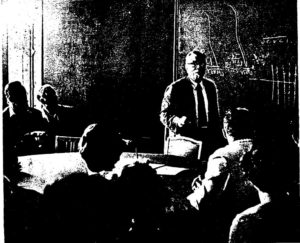Alexey Pajitnov was the proverbial Russian bear, albeit more of the teddy than the grizzly variety. Big-boned and bearded, loose-limbed and always a little rumpled, his sunny disposition would brook no opposition even from the perpetual gray of the Mirror World. Not that he had much cause to complain, all things considered. Compared to many of his fellow citizens, Pajitnov had an easy time of it, being born into an intellectual family in Moscow; both of his parents were writers. Like many Russians, Pajitnov’s parents harbored no love for the Soviet system, but weren’t willing to die in a gulag in the name of some abstract cause of Freedom either. They taught their son to master the art of remaining quietly noncommittal when politics entered a conversation, and when the day came for young Alexey’s class to visit Lenin’s tomb, his mother wrote a note to the school saying he was sick. For the nonce at least, such small rebellions would have to suffice.
A lover of logic games and puzzles from an early age, Pajitnov excelled at math competitions as a teenager, and went off to university to study the subject. “Mathematicians are usually very strange people,” he admits. This mathematician, however, was a little different from the norm, a kid who loved movies almost as much as he loved numbers, who wasn’t any stranger to vodka and girls. With his big toothy smile, Pajitnov could be ingratiating even when he wasn’t trying to be. It was a quality that would serve him as well as an as-yet latent talent for game design over the course of the very unlikely career to come.
In 1984, Pajitnov was 28 years old, married, and starting a family; his wife was an English teacher, another stroke of luck that would serve him well in his future life. His early interest in pure mathematics had long since passed into a fascination with computers. “It doesn’t matter to a hacker what he is working on,” he says. “It could be a game or an abstract math problem, but if a computer is involved, he is a god and can do whatever he wants inside that world.” Living in the restricted society of the Soviet Union, such a sense of control was very appealing indeed to Pajitnov. He’d therefore managed to get a position at the Moscow Computer Center of the Soviet Academy of Sciences, one of the oldest and most important hubs of computer research in the Soviet Union. (You may recall from the first article in this series how prominently it featured in the first extended visit by an American computing delegation to the Soviet Union back in 1959, or from the second article how it was the workplace of Leonid Genrikhovich Khachiyan when he made a significant discovery in linear programming.)
But with the excitement of Soviet computing’s early, pioneering days and the heyday of the cybernetics dream now well in the past, the Computer Center was limping along, like the rest of the country, without a great deal of direction. Pajitnov was supposed to be doing research into artificial intelligence and voice recognition, but that was difficult given the overcrowded conditions at the Computer Center. There was barely enough physical space to breathe there, let alone get real work done. He took to working a late shift, going in in the afternoon and staying at the office until around midnight, because that was the only way he could get a desk to himself. Nor was he happy about the uses to which the state dreamed of putting his work in voice recognition, such as a bugging device that would switch on automatically if certain words were spoken within a room. Still seeing programming as a form of escape, he started spending much of his time tinkering with games, beginning a friendly competition with a similarly disposed colleague named Dmitry Pavlovsky to see who could make the most popular software distractions. The computer on which they both worked was called the Elektronika 60, a clone of the American DEC PDP-11 minicomputer. Their terminals had no graphics capabilities whatsoever, sharply limiting the sorts of designs they could hope to implement. Initially, the audience they wrote for consisted only of their comrades at the Computer Center.
That began to change when Pajitnov and Pavlovsky added a third programmer to their little game-making collective. Vadim Gerasimov was a 16-year-old hacker who, thanks to the good offices of a high-school teacher, had gotten permission to hang around the Computer Center. Gerasimov became something of an expert in programming a very exotic bit of kit in the Soviet Union of those times: the EC-1840, a Soviet knockoff of the IBM PC, of which the Center had a few examples. As Pajitnov and Pavlovsky came up with promising games on their text-only Elektronika 60 terminals, Gerasimov ported them to the EC-1840, adding real graphics and sound effects.
Later accounts would often paint Pajitnov as a complete babe in the woods when it came to the idea of selling games, but reality paints a somewhat different picture. While they were isolated from goings-on in the West in countless respects, he and his two friends were tuned-in enough to know that plenty of people on the other side of the Iron Curtain were making real money doing exactly what they were doing. Unfortunately, it wasn’t at all clear how they could turn games into a business in the Soviet Union, where business itself in the Western sense was largely illegal, where there was no way whatsoever to buy software even if you had the money to do so. So, Gerasimov distributed their games for free among the few other people in Moscow with access to the computers that were needed to run them, and the trio continued to complain, speculate, and dream.
The game that would change Pajitnov’s life and in its modest way change the world was born when he came across a pentomino puzzle in a toy shop one day. If you’ve played the popular board game Blokus, you have a good idea what such a thing is all about. A set of geometric shapes made up of differing arrangements of five squares — thus the name of “pentomino” — must be arranged onto a grid to fill every space on the grid and/or to use up every shape. For a mind like Pajitnov’s, the attraction was immediate. Indeed, pentomino puzzles were actually a rediscovery rather than a new find for him; he’d spent many hours playing with them as a boy.
His first reaction to this reignited passion was to attempt a fairly literal translation of a pentomino puzzle to the computer, departing from his inspiration in just one significant respect. Pajitnov realized that five-square shapes would be too complicated on the computer, too difficult for the programmer to draw and too difficult for the player to place in the limited screen space available. So, he decided to use four-square shapes — tetrominoes — instead. He called his game Genetic Engineering. The player had to move the pieces around the screen using the arrow keys, assembling them into larger “organisms.” But the concept lost something in the translation from the physical to the virtual. It wound up being, in the words of Vadim Gerasimov, “rather dull” to play.
Then a new idea burst into his imagination with the force of vision. He saw a never-ending stream of shapes falling toward the bottom of a rectangular “glass” at ever increasing speeds, the player trying frantically to arrange them into filled rows. Once filled, a row would be wiped off the screen, buying the player a little time and space in what must ultimately be a fruitless battle against entropy. Pajitnov called his game Tetris, a contraction of “tetromino” with, for reasons nobody could ever quite get him to explain, “tennis.” (One is tempted to imagine the name being some form of homage to Tennis for Two, arguably the first true videogame ever, and/or Pong, the game of electronic table tennis that kicked off the arcade craze in the West, but Pajitnov was nowhere near familiar enough with the Western videogame tradition to draw such inspiration from it. Chalk it up as just one more example of so many early videogame designers’ odd fixation on tennis.)
Working on his text-only Elektronika 60 terminal, Pajitnov was forced to draw the “graphics” using brackets and spaces. Monochrome, absolutely silent, and possessed of plenty of ugly flicker as the shapes drew and erased their way down the screen, Tetris was a long way from any Westerner’s idea of a cutting-edge videogame. But it didn’t matter. From the first, Tetris captivated.
Some years later, pop psychologists would take to using the term “Tetris Effect” to describe the state of mental flow, of complete yet almost unconscious absorption, that could cause Tetris players to begin seeing the real world around them as a manifestation of the game. But the phrase could serve equally as shorthand for the effect Tetris has always had on the productivity of people who encounter it. When Pajitnov started to show the game to his colleagues, the sterile confines of the Moscow Computing Center became host to the first ever cases of both versions of the Tetris Effect. “Everybody who touched this game couldn’t stop playing it,” remembers Pajitnov. His fellow programmer Mikhail Kulagin remembers how “people started to gather together and play Tetris. There was a time when the whole Computer Center started to play Tetris.” “The game was compelling, and many of the employees got carried away, often to the detriment of their work,” says Yuri Yevtushenko, the director of the Computer Center. Vladimir Pokhilko, a psychology researcher working on a project with the Computer Center, saw the game there, liked it, and made a copy to play back at the medical institute where he usually worked. Productivity plummeted so badly thereafter that he finally had to erase every copy he had handed out. “I can’t live with your Tetris anymore,” he told Pajitnov, only half joking.
Of course, the Tetris Effect wasn’t wholly unprecedented in the hallowed halls of institutional computing. One is reminded of the unleashing of Adventure upon the world of Western computing in 1977, and the apocryphal claim that it set an entire industry back by two weeks while everyone solved it. Tetris, though, was even more dangerous in that it could never be solved. There was just that never-ending stream of falling shapes, and that never-ending compulsion to clear a few more rows than you managed the last time around.
With Tetris so popular inside the Center, it was inevitable that Vadim Gerasimov would program it for the EC-1840 in short order. Thus Gerasimov’s version became the first of the countless thousands of ports of Pajitnov’s original that were still to come. Writing in Turbo Pascal, a programming language that had been smuggled out of the West and was now as commonplace on Soviet PC clones as it was back where it had come from, Gerasimov not only added color to the game but did much to refine the way it played. In a telling indication that he and his partners continued to harbor grander, more international ambitions than what might be apparent on the surface, Gerasimov also translated all of the text in the game to English. Even if it never left Moscow, doing so would ironically make it more likely to be taken seriously by his fellow Russians. A huge cachet came attached to games out of the West; fascination with the Mirror World applied no matter which side of the mirror you happened to be on. And if Tetris should get beyond Moscow, beyond the Soviet Union even… well, you never knew, right? Gerasimov started passing Tetris around Moscow for free, as he had his previous ports of Pajitnov and Pavlovsky’s creations.
The Tetris Effect didn’t disappoint. Pajitnov describes the game spreading across Moscow, then across the Soviet Union, then across Eastern Europe “like a wood fire.” The fire’s spread was limited only by a lack of tinder, in the form of extant IBM PC clones behind the Iron Curtain to run the game. Hackers being hackers, other programmers took up the slack. Within a year, very good versions of Tetris were available on relatively more common homegrown Soviet microcomputers like the Agat and the BK-0010, along with their equivalents in many other Warsaw Pact countries. The Tetris Effect followed in the wake of each new version. For instance, the management of the Scientific Research Institute of Computing Systems, the home of the Agat, complained that further development on the machine’s systems software essentially stopped once Tetris invaded the programmers’ offices.
A Digression on Design
My task of writing about Tetris as a design is made easier by the game’s sheer ubiquity. In 2010, it was estimated that two-thirds of all Americans had played Tetris at one time or another. Never before have I and never again will I be able to write about a game with more confidence that absolutely everyone likely to read my words has played it. So, I won’t bore you with a detailed description of its mechanics.
Yet the what of Tetris isn’t the why. Why do so many people find this incredibly simple game so addictive?
One answer is its unpredictability. Often classified as a puzzle game, Tetris can just as validly be seen as a throwback to the classic arcade game. Reflexes are as important as logic, and, thanks to the magic of the random-number generator that decides which of the seven possible shapes to drop next, every game of Tetris is different. If Tetris was deterministic in the way of its inspiration, the pentomino puzzle, it could be solved and dispensed with. Ditto if it offered a winning screen of any sort. But a game of Tetris ends always in defeat and that siren call to try again for a higher score. (“Life is hard and unjust, and ends always in death,” my father-in-law loves to say in his deadpan German. Tetris agrees wholeheartedly with that philosophy.)
The sheer simplicity of Tetris is actually its greatest asset, not only for the would-be player but also for the would-be programmer. Requiring as it does no artificial intelligence or advanced algorithms of any stripe, it’s become the first game ever made by thousands upon thousands of programmers over the course of decades. The countless legitimate and illegitimate versions have won it the official title according to Guinness of most-ported videogame in history. Whatever digital gadget you care to name, chances are it plays Tetris.
Yet the game’s simplicity has also been of more subtle benefit. Within the context of its goals, no other game design has ever been more perfect than Tetris. As many disappointing attempts to iterate on the concept proved — including quite a number of attempts by Alexey Pajitnov himself — you can’t add to, take away from, or modify Tetris in any way to turn it into a better game of falling shapes. The first iteration on the Tetris concept remains the definitive iteration, almost a unique phenomenon in the history of videogames.
Tetris is as abstract as any videogame ever made, without even the modicum of context provided by arcade classics like Pac-Man and Centipede. You’re never given any reason why you need to clear row after row of shapes; the game lacks any sense of embodiment or physicality whatsoever. For this reason, it’s often been held up as an ideal by members of the ludological school of game design. By many metrics the most popular videogame ever created, Tetris is also the ultimate in process intensity, proof positive that games are better — or so the ludologists allege — without messy distractions like story. When the narratological versus ludological debate was still in its infancy, academic theorist Janet Murray decided — full speed ahead and damn the torpedoes! — to wrench Tetris into a narratological frame. “The game is a perfect enactment of the overtaxed lives of Americans in the 1990s,” she wrote, “of the constant bombardment of tasks that demand our attention and that we must somehow fit into our overcrowded schedules and clear off our desks in order to make room for the next onslaught.” Even if one forgot that this “perfect embodiment of the overtaxed lives of Americans” was designed by a Russian who had never been to America, it sounded a little ridiculous, and the ludologist contingent justifiably savaged her for it. Sometimes a cigar is just a cigar, and sometimes an abstract game of falling shapes is just an abstract game of falling shapes.
In its abstraction and its complete disinterest in the experiential side of gaming, Tetris is the extreme opposite of the sort of games I usually write about. As an old literature major, I tend to approach games with an eye to story, texture, theme… all the things Tetris so conspicuously lacks. It may come as little surprise, then, that the Tetris Effect is to a large extent lost on me. Personally, I find Tetris amusing in short bursts, but grow bored in pretty short order. I appear to be immune to its legendary addictive qualities. I can recognize that it’s the quintessential masterpiece of minimalism in game design, even as I also recognize that I’m really not a minimalist sort of guy. Certainly I don’t think that we can take Tetris‘s undoubted success as a game design as proof that other, radically different approaches to the art are illegitimate. Tetris, a game bereft of context — almost bereft, one is tempted to say, of culture — is very nearly the polar opposite of what I personally look for in a game. In that perverse light, perhaps the greatest tribute I can offer to its genius is to note that I can actually enjoy it in short bursts.
If I wished to sculpt a less personal critique of Tetris, I would have to start with the words that always seem to surround it: words like “addiction,” “compulsion”, “obsession.” Writer Jeffrey Goldsmith coined the term “pharmatronic” to describe it — as in, an electronic drug. Pajitnov responded that “many people say that, but my feeling is it’s more like music. Playing games is a very specific rhythmic and visual pleasure. For me, Tetris is some song which you sing and sing inside yourself and can’t stop.” Fair enough — except, as Goldsmith himself countered, a song that gets stuck in your head can start to feel as much like a compulsion as any narcotic. A 2014 study showed that playing Tetris reduced cravings in smokers and drinkers by 24 percent. Could this be a case of one sort of addiction supplanting another?
While a dependence on Tetris is probably preferable to a dependence on cigarettes or alcohol, it is interesting to note how often negative adjectives like “addictive” are used in connection with Tetris in lieu of words with more positive connotations. As I viewed the (highly recommended) film Ecstacy of Order, about a Tetris “world championship,” I couldn’t help but wonder whether most of the eccentric cast of characters on the screen were really better off for having Tetris in their lives. “I’ve been playing Tetris for, like, twenty years” says one; “I don’t even want to know how many hours I’ve played Tetris,” says another; “I play it, like, non-stop,” says a third; “I daydream it during the day and I have Tetris dreams at night,” says a fourth. Perhaps most ominously, one character in the film describes playing Tetris as “programming yourself to do it.” There is, it seems to me, not a lot of joy in Tetris.
Beginning in 1992, University of California, Irvine, professor Richard Haier conducted a series of studies measuring the effect playing Tetris had on subjects’ brain activities. He discovered that as his subjects spent more time with the game and were able to advance to higher levels their brains showed less activity rather than more as they played. There are many ways to interpret these results, most of which I’m eminently unqualified to even broach. It does, however, strike this non-neuroscientist as interesting that Tetris comes to engage less of the mind the longer you play it. All others things being equal, I think I prefer games which do the opposite.
But whatever your opinion of Tetris as a force in gaming and, indeed, in society, few would argue that there’s genius of some sort or other in this simple game of falling shapes. Many more words than those I’ve just spent here have been used trying to come to terms with why so many people find it so irresistible. Call it genius, call it kismet, call it addiction if you must. In the end, it’s grappling with the ineffable.
Tetris had become a sensation within the circumscribed and sparsely populated world of Eastern European computing, but it remained unknown in the West. In 1986, that situation began to change, thanks to a chance encounter in Budapest, Hungary.
The confluence of factors that made Hungary Tetris‘s port of departure for Western climes began with the country’s long pre-communist tradition of scientific and engineering excellence. In the twentieth century alone, this tradition had yielded such pivotal figures as John von Neumann, the most important early computer-science thinker this side of Alan Turing, and Edward Teller, the inventor of the hydrogen bomb. In the Soviet era, Hungary had played a major role in Project Ryad and other joint computer-development projects, and had been officially designated, along with the similarly capable Czechoslovakia, as one of the Warsaw Pact’s two non-Soviet centers of electronics development and manufacture. The Hungarian government took the assignment very seriously; children were required to start taking computer classes while still in elementary school.
Indeed, the Hungarian version of communism in general was progressive in some ways, at least by the standards of most of its Warsaw Pact peers. Years before Perestroika, Hungary had begun allowing a certain degree of private enterprise and private ownership. The result was an economy that worked just a little better than was the norm behind the Iron Curtain, one that could even manifest a modicum of entrepreneurial spirit on occasion.
The final great advantage enjoyed by Hungary was that of simple geographic proximity. Budapest and Vienna were only about 100 miles apart, the shortest distance between any two major Eastern and Western capitals. Alone among their peers living behind the Iron Curtain, Hungarian citizens could slip across the border for a day or a weekend in the West, then slip back into their homeland relatively painlessly. A steady stream of licit and illicit goods flowed into Budapest with them, and from there across the rest of Eastern Europe. For example, the master copies of most of the hand-dubbed cassettes of Western rock music that were at the center of a booming underground trade throughout the Warsaw Pact had their point of origin in the bright shopping districts of Vienna.
By the mid-1980s, the Hungarian habit of smuggling in goods from the West, not officially condoned by the country’s government by any means but not all that seriously prosecuted either, had come to include computer software and even hardware. A fair number of Hungarians managed to secure for themselves Commodore 64 systems, the ultimate gaming machine of the era; again, this made them uniquely blessed among Eastern Europeans. Others had access to the knockoff Sinclair Spectrums that were being produced in several Warsaw Pact nations. Every weekend a huge flea market was held in the courtyard of Budapest’s Petőfi Csarnok concert hall, during which thousands of pieces of software were sold, almost all of it pirated from the West. A Hungarian cracking group who called themselves FBI Crew became a prominent member of the international piracy scene as early as 1984, a first for any Eastern European country. FBI Crew made their name as “importers” from the West to the East, receiving pirated software from Western contacts via the post and then selling or trading it to locals. Thus the group became just one more part of Hungary’s cottage industry of bridging the capitalist and communist worlds.
Along with all of the goods moving eastward, it wasn’t totally unknown for Hungary to send something to the West. In the late 1970s, Ernő Rubik, a Budapest architect, had come up with a three-dimensional puzzle, a cube of colored squares which challenged one to twist and turn them in such a way as to make each face of the cube a single color. Tibor Laczi, a Hungarian entrepreneur who had partnered with Rubik, took it to the Nuremberg Toy Fair in West Germany in 1979, and soon signed a deal with the Ideal Toy Company to sell it throughout the West. The Rubik’s Cube became an early-1980s pop-culture sensation, selling in the hundreds of millions and spawning a whole library of often-bestselling books purporting to describe the best way to solve it. For once, the communists had managed to beat the capitalists at their own game.
Robert Stein saw the story of the Rubik’s Cube as an inspiration. Born in 1934 in Hungary, he’d come to Britain as a refugee following the failed 1956 Hungarian Revolution. There he’d made a successful career for himself in office equipment and electronics, going from selling typewriters to calculators to microcomputers. As managing director of an electronics distributor called Vulcan, Stein played a major role in popularizing Commodore’s first low-cost home computer, the VIC-20, by getting it into department stores across the United Kingdom.
Commodore at the time sold games for their computers as well as hardware, and was keenly interested in acquiring new titles on the cheap. Stein, for his part, still had connections in Hungary; in fact, he had recently inked a deal that let Vulcan import single-purpose chess-playing computers from Hungary for sale on British high streets. He knew there was a treasure trove of eager young programming talent in his homeland with no commercial outlet for their skills. Best of all, he knew that, the differences between the economies of East and West being what they were, he could hire these programmers cheap. He quit Vulcan and started a company of his own, naming it Andromeda Software. He would buy games from a stable of Hungarian hackers and sell them to Commodore and other Western publishers eager for more product to feed the demand of Britain’s big home-computing boom.
Stein had no personal interest in games, and Andromeda didn’t place a big priority on quality as opposed to quantity. Over the course of just two or three years, he imported several dozen cut-price original games and ports, many of which went entirely uncredited to his company on the packaging and none of which are much remembered today.
When the home-computing boom began to tail off circa 1985 and the market settled back toward its natural equilibrium, it was largely the second-tier companies like Andromeda that failed first. Stein’s little venture would doubtless have fallen into the dustbin of history without another peep had he not dropped in on the Institute of Computer Science in Budapest, one of his big sources of programming talent, one day in 1986, just to see if they had anything new and interesting in the works that might save his declining business. Stein:
We were wandering around in a big room with all kinds of computers going, all kinds of software going. And suddenly in a corner I saw a game which consisted of bricks coming down, or some kind of shapes. It was tucked away somewhere in a corner. I was asking, “What is this?” They said, “Oh, ignore it.” So we wandered on, but I kept coming back to it.
Stein eventually sat down to try the game, and promptly had an experience all too typical of many avowed non-gamers’ first exposure to Tetris: he couldn’t stop playing. His tour guides could only sympathize; their Institute was itself in the full thrall of the Tetris Effect. But the reason they’d been so reluctant to show the game to Stein soon became clear: Tetris wasn’t actually one of their games. The Hungarians had ported the game, just for personal pleasure, to the Commodore 64, a far more marketable platform in Britain than the IBM PC on which Vadim Gerasimov’s version ran. Stein would have happily bought that version from them without another thought about its real origins. But the Hungarian programmers were too honorable to take the deal. Tetris simply wasn’t their game to sell to him, they insisted. If he wanted to buy it, he would have to do so from the Russians who had originally created it.
Back in Moscow, a colleague of Pajitnov at the Computer Center handed him a telex message written in English. “It looks like someone is interested in your game,” the colleague said. The message was indeed from a someone in Britain, who said he had seen Tetris while visiting Hungary and wished to license it and sell it in the West. Pajitnov, who had dreamed for years of something like this happening to rescue him from his life of institutional captivity, felt like a Cinderella who had just been handed a glass slipper. Still, as he would soon learn at extensive length, the devil is always in the details. It took him several weeks just to collect the authorizations he needed to send a telex back. “Yes, we are interested,” he wrote. “We would like to have this deal.” There followed a trans-European dance that sometimes resembled a farce more than a serious negotiation, complicated by the limited organs of communication between East and West and the Russians’ sketchy command of English. Most of all, though, the whole situation was just completely unprecedented on the Soviet side. “We had no idea what to do,” Pajitnov says.
Convinced by the Russians’ initial response that they were ready to sign a contract, and convinced by their seeming lack of business acumen that he would be able to dictate the terms of that contract, Stein started to shop Tetris to publishers while the negotiating farce had hardly begun. In a telling sign of his conviction that this game could be huge, he even reached out to American publishers, something he had never bothered to do with his other bargain-bin games. There’s an amusing entry in the diary of Jordan Mechner of Prince of Persia fame, who was working at Brøderbund Software in California at the time he wrote it. It’s dated October 23, 1986: “Everyone in the office has been playing a lot of Tetris — a Russian submission for the IBM PC. It’s a classic, like Breakout.” October 31 finds him beating out his colleagues for the number-one spot on the intra-office Tetris high-scores list. The Tetris Effect had come to Brøderbund, and to plenty of other British and American publishers as well.
Yet Stein found the game to be a harder sell than he’d anticipated. For all that everyone who sat down to play it seemed to have difficulty standing up again, Tetris was just so different from anything else that marketing departments didn’t know quite what to do with it. It was all just so abstract. There was no obvious hook: no starring character, no story line, no explosions. What would they put on the box? Even Brøderbund, home of The Print Shop and Carmen Sandiego, whose instinct for selling software to Middle America was normally unparalleled, took a pass, despite the Tetris Effect taking place right there in their offices. “I don’t think Brøderbund is going to publish it,” wrote Mechner in disgust. “The knaves.” A Brøderbund executive, seeing his programming staff so consumed by the game, had allegedly called it “a game only programmers could like.”
In the end, Stein wound up inking a deal in June of 1987 with the British publisher Mirrorsoft, a well-funded operation owned by the newspaper tycoon Robert Maxwell. Through a Byzantine array of tax dodges involving a charitable trust based in Liechtenstein — the Maxwell business empire was built on the most ethically shaky of foundations, as would become clear when it collapsed in scandal a few years later — Maxwell also owned a controlling interest in the American publisher Spectrum Holobyte, an up-and-comer best known for their complicated, very un-Tetris-like military simulations. Mirrorsoft, who had no presence in North America, brokered a deal to give Spectrum Holobyte publication rights across the pond. But Stein still hadn’t secured the Tetris rights from the Russians; he had sold two separate publishers a game he didn’t yet own. Don’t worry, he assured them; the deal was all but done. But the reality was that a deal with the Russians seemed farther away rather than nearer with each passing week.
Any dreams Pajitnov might have had of profiting from Tetris had been strangled. His managers had gotten word of what was going on with his game, and had taken over the negotiations, such as they were. As an employee of the Moscow Computer Center, Pajitnov was informed, any and all software he created there belonged to the Soviet state. “Nobody gave a shit about my small game,” says Pajitnov — other than, apparently, to make sure he didn’t make any money off it. “Games were absolutely alien to their nature.” The dialog with Stein proceeded at the speed of government. Desperate to get a firm yes, frustrated by the noncommittal and poorly translated replies he continued to receive to his telexes, Stein secured a visa and visited Moscow personally at last. There he encountered a scenario that seemed to confirm every Western stereotype about life in the Soviet Union. In a chilly, undecorated room containing only a single huge table and about fifty uncomfortable chairs arrayed around it, he confronted Alexey Pajitnov, little more than an interested observer at this point, and the half a dozen or so bureaucrats who now controlled Tetris‘s fate. Always more noted for his pugnaciousness in business than his charm, Stein misjudged the power dynamic in the room and played everything wrong. He tried to butter up Pajitnov, the least empowered person there, saying that “in our country the most important person is the one who designs the game. I’m here to listen to his wishes because if we don’t sign a contract, it is he who will suffer.” Not only did this alienate the bureaucrats, who had little interest in attributing credit for what they regarded as the property of the Soviet state, it also had the opposite of the intended effect on Pajitnov. He saw Stein’s words for the clumsy pandering they were, and took an immediate dislike to him that would never abate.
A frustrated Stein flew home no closer to a deal than before, even as the planned release date inched closer. He decided that if the Russians continued to prove difficult he’d just let the game come out anyway. What could do they do about it, trapped behind the Iron Curtain as they were? In the meanwhile, his negotiating tactics didn’t exactly smack of good faith. He offered them what sounded like a preposterously generous royalty of 75 percent — but the fine print revealed that this was 75 percent of the game’s profits after everyone else had taken their cuts, not 75 percent of gross sales. At another point, he offered to pay them in Commodore 64 computers instead of cash, a scheme ripe for accounting tricks on his side. The Russians may not have known much about the videogame business, but one thing life in the Soviet Union inculcated in everyone was a keen instinct for the double-cross. Liking Stein less and less, they dragged their feet more and more.
When a final impassioned letter to the Russians fell on the usual deaf ears in December — he asked for “a simple letter stating that you approve the terms under which we have signed this contract with Mirrorsoft,” but got no such thing — Stein decided to lie to his other partners about the real state of affairs. He told Mirrorsoft and Spectrum Holobyte, who had already missed the Christmas buying season and were making their impatience known in no uncertain terms, to go ahead and release their versions of Tetris, telling them that he now owned all the rights. Maybe, he thought, the Soviets would get serious about negotiating at some point, and they could make a retroactive deal. If not… well, they’d had their chance. And anyway, taking 100 percent of the profits that came back to Andromeda for himself was a lot better than taking just 25 percent.
Alongside rewriting the game for several popular Western computers, Mirrorsoft and Spectrum Holobyte solved the marketing problem brilliantly. They asked themselves what was the most salient point about the game, the thing you’d be most likely to mention first when describing it to a friend. For all the brilliance of the game itself, the answer was of course its origin in the Soviet Union of all places. That’s how they should market it — by playing up its exotic origins in the Mirror World for all they were worth. They designed a commie-red box for the game, with the name written in Cyrillic script, the final character drawn in the form of a hammer and sickle. They replaced the original game’s silence with a soundtrack of Russian folk songs. They replaced its blank backgrounds with iconic Russian and Soviet imagery, some of it ripped straight from the headlines; the imagery included the brave (and probably mentally ill) West German activist Mathias Rust landing his private plane in Red Square, an incident which had garnered huge international attention just the previous May. Timeless though Tetris is as a piece of game design, its first commercial incarnation is as of-its-time as a game can be.
Fortunately, its time was a heady time indeed. Since Pajitnov had programmed his first version of the game, the world had changed dramatically. The Cold War was thawing; Glasnost and Perestroika were the new order of the day. A few years earlier, no publisher would have dared release a game in a box that looked like this one, for fear of being run out of business on a rail as fifth columnists in league with what Ronald Reagan liked to call the Evil Empire. Now, with fear of the Mirror World in the West being replaced by a friendlier but no less abiding sort of curiosity, the Soviet angle was the perfect marketing coup.
Spectrum Holobyte in the United States promoted the game with more energy and enthusiasm than Mirrorsoft in Britain. They spared no expense in emphasizing their theme of cross-cultural communication. Following an appearance at the Winter Consumer Electronics Show, Tetris made a more lavish public bow that same January of 1988 at San Francisco’s Herbst Theatre, the site where the United Nations charter had been signed in 1945. Spectrum Holobyte invited the ambassador to San Francisco’s Soviet consulate to attend the unveiling. On the trade-show circuit, the game was presented by Ronald Reagan and Mikhail Gorbachev lookalikes.
Robert Stein’s instinct that Tetris could be huge was proved correct. At the 1988 Software Publishers Association Excellence in Software Awards, the game won virtually every category conceivably open to it: “Best Action/Strategy Program,” “Best Entertainment Program,” “Best Consumer Program,” “Best Original Game Achievement.” Yet such recognition among insiders was far from the greatest of Tetris‘s achievements. Spectrum Holobyte had recognized early the potential of Tetris for opening gaming up to a whole new demographic. In a telling demonstration that they expected it to be played in offices at least as often as it was in bedrooms, they had built a “boss key” into the IBM PC version of the game: a hotkey which instantly paused the game and replaced it on the screen with an innocuous-looking spreadsheet, just the thing for when the manager came around peering into people’s cubicles.
Spectrum Holobyte’s expectations weren’t disappointed. The perfect exemplar of a casual game many years before the so-called casual market became a recognized part of the industry, Tetris appealed to people who could never have imagined playing a computer game before encountering it. It garnered glowing write-ups in places where few computer games had ever ventured before, such as the lifestyle sections of newspapers like the New York Times and Chicago Tribune. It was in fact the latter that first coined one of the most potent Tetris memes: that it might just be a plot on the part of the old Soviet hardliners to ruin the productivity of the West, their revenge for losing the Cold War. Knowing good marketing copy when they saw it, Spectrum Holobyte soon worked this angle as well into their presentations and advertisements. Ditto the description of Tetris as “the Rubik’s Cube of software,” which drew a line between the last great Eastern European puzzle phenomenon to strike the West and this latest example of Eastern deviousness.
It all paid off splendidly where it really mattered. The Spectrum Holobyte version of Tetris alone sold over 100,000 copies in its first year, a substantial success by the standards of the time. More remarkably, its sales actually increased rather than decreased over time; its second year brought a figure of 150,000.
For all that, though, sales of the Mirrorsoft and Spectrum Holobyte releases were but the merest shadow of what was still to come. The business of selling Tetris, already a complicated tangle of personalities and cultures, was about to get a lot more complicated for everyone concerned.
(Sources: the books The Making of Prince of Persia: Journals 1985-1993 by Jordan Mechner, Game Design Theory and Practice by Richard Rouse III, Hamlet on the Holodeck: The Future of Narrative in Cyberspace by Janet H. Murray, Freax: A Brief History of the Computer Demoscene by Tamás Polgár, Game Over: How Nintendo Conquered the World by David Sheff, and The Tetris Effect: The Game That Hypnotized the World by Dan Ackerman; the BBC television documentary From Russia with Love; the documentary film Ecstasy of Order; STart of June 1990; Compute! of April 1990; Your Computer of June 1982; Popular Computing Weekly of March 15 1984; Computer Gaming World of September 1993; Compute! of June 1988; The Boston Globe of January 30 1990; The Los Angeles Times of September 24 1992. Online sources include Jordan Mechner’s Prince of Persia postmortem at the 2011 Game Developers Conference, Vadim Gerasimov’s “Tetris Story,” and Jagger Gravning’s “The Man Who Made Tetris.” Once again and more than ever, thank you to Peter Sovietov for being my advisor, translator, and spirit guide to Russian and Soviet computing.)

